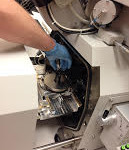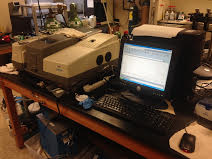My final was once again busy. Syed was at a hydrogen production conference in San Diego, so I spent the week working on lipid bilayers with Shanshan.
We spent most of Monday testing lipid solutions on our membranes at different pH levels. We would use the pH scale to measure the levels while adding either hydrochloric acid to lower the pH or sodium hydroxide to raise it. It’s challenging because one drop can change the pH significantly and then sometimes almost not at all. We would find ourselves overshooting our target pH of about 2.4 or 8, and so would buffer the solutions until they were perfect.
The flux measurements taken on the membranes later that day showed very little sequence in the data, and unfortunately no conclusions could be drawn. I prepared a research report on Tuesday morning for our meeting in the afternoon with Dr. Knutson and Dr. Rankin.
On Wednesday I prepared mesoporous titania on surface modified alumina. Later I took flux measurements and we took SEM (scanning electron microscope) imaging of the samples. We prepared lipids on them and took more flux measurements.
On Thursday I used the FTIR (fourier transmission Infrared) Spectrometer to look at the spectra that the titania films would give off when they had a lipid on them. The whole point of this experiment was to see if a lipid bilayer had formed versus just a vesicle. The reason we attempted this experiment was that Dr. Rankin had found some literature on it and I read it to see how the experiment had been done.
FTIR takes quite a long time to complete about 20 minutes per sample so I spent a lot of Thursday afternoon and Friday morning waiting around in the lab for results. On Friday we went to lunch in the afternoon at a Korean restaurant. When we got back to the lab I finished one last FTIR sample and said my goodbyes to some of the best people I’ve ever met.
I started driving west, and by Sunday at noon I was back home in Telluride.
Thank you Pinhead for giving me this experience and allowing me to not only learn about chemical engineering and the importance of accurate data, but the development of new, world-changing materials.



There are no comments published yet.